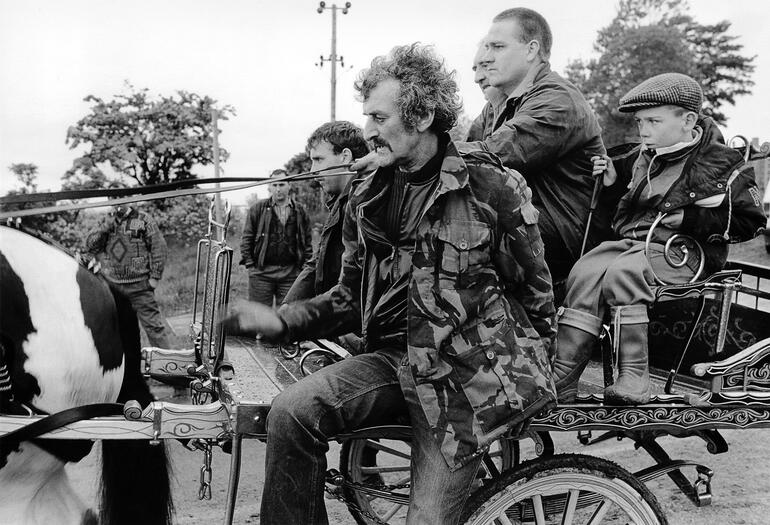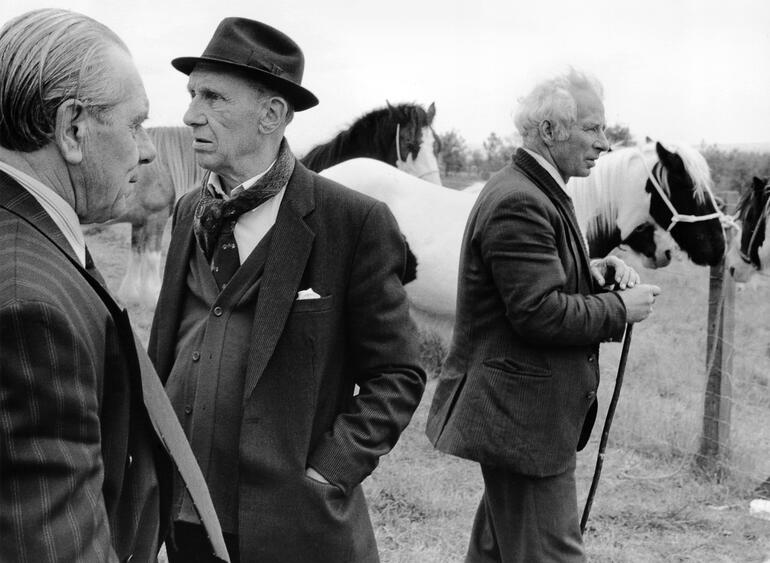Spotlight
Beverly Conley - Portfolio Contest Winner
“Usually when I do a documentary project I have a contact person who would pave the way for me to photograph. But with this project I simply went in on my own.”

Family, Appleby, Cumbria, England, 1991
Emanare, v, (Latin): flow from or bring forth, to radiate, promulgate; spread abroad
Notwithstanding the crisp elegance, the respectful, deft rendering of her portraits, there’s a discernible instructive quality to Beverly Conley’s photographic canon. Call it an enamare, if you will, that’s intellectually expansive as it is intimate.
Seemingly comfortable in the role of a well-traveled visual docent, a learned and respectful cicerone, Conley wordlessly guides viewers to parts unknown; where today’s modern primitives dwell. The conceit is borne out by her informal mission statement.
Notwithstanding the crisp elegance, the respectful, deft rendering of her portraits, there’s a discernible instructive quality to Beverly Conley’s photographic canon. Call it an enamare, if you will, that’s intellectually expansive as it is intimate.
Seemingly comfortable in the role of a well-traveled visual docent, a learned and respectful cicerone, Conley wordlessly guides viewers to parts unknown; where today’s modern primitives dwell. The conceit is borne out by her informal mission statement.

Gentlemen, Appleby, Cumbria, England, 1991
Expressed on her website, sharing space with mention of six awards, 15 collections and 46 exhibits, the Benicia, CA-based Conley finds “true satisfaction in long-term, self-assigned projects that focus on individuals and contemporary society.” Her bio walks back a personal-professional quest that’s “entered the private worlds of Gypsies (in England), the Cherokee Nation in Northeast Oklahoma, West Virginia steelworkers… and Boston’s Cape Verdean communities.”
Personally speaking, each drop-in of Conley’s Appleby Horse Fair series compelled a deeper dive: to the origins of this yearly gathering, if not the commingling of nomadic-itinerant Irish Traveler ethno-culture with the far larger, Gypsy-Roma.
“My goal at the Fair,” Beverly began in a Zoom call, “was to learn as much as I could about the Romani and Travelers way of life, be able to share it with others. It was thought the Fair originated from a royal charter to the borough of Appleby from King James the 11th in 1685. But research found the charter was cancelled before it was enacted.”
Personally speaking, each drop-in of Conley’s Appleby Horse Fair series compelled a deeper dive: to the origins of this yearly gathering, if not the commingling of nomadic-itinerant Irish Traveler ethno-culture with the far larger, Gypsy-Roma.
“My goal at the Fair,” Beverly began in a Zoom call, “was to learn as much as I could about the Romani and Travelers way of life, be able to share it with others. It was thought the Fair originated from a royal charter to the borough of Appleby from King James the 11th in 1685. But research found the charter was cancelled before it was enacted.”

Children in Front of Their Vardo, Appleby, Cumbria, England, 1991
Beverly continued. “The new Fair, held in early June, began in 1775 for sheep, cattle and horse dealers to sell their stock. By the 1900s it had evolved into a major Romani/Travelers Fair. It is considered a Peoples Fair because no group claimed ownership of the event. Or is charged to attend.”
This featured portfolio was shaped by a visit in 1999. Bringing background to foreground, Beverly described The Appleby Horse Fair as the largest gathering of Romani and Travelers in Europe.
“Usually when I do a documentary project I have a contact person who would pave the way for me to photograph. But with this project I simply went in on my own. This proved that it certainly was possible to meet people who are of a totally different culture and make them feel comfortable enough to let me into their world.”
This featured portfolio was shaped by a visit in 1999. Bringing background to foreground, Beverly described The Appleby Horse Fair as the largest gathering of Romani and Travelers in Europe.
“Usually when I do a documentary project I have a contact person who would pave the way for me to photograph. But with this project I simply went in on my own. This proved that it certainly was possible to meet people who are of a totally different culture and make them feel comfortable enough to let me into their world.”

Gentlemen Negotiating a Horse Deal, Appleby, Cumbria, England, 1991
Therewith she moved and photographed some of the 5,000 Romani and Travelers “who come from all over England in motorized caravans and ornate vardos [horse-drawn wagons]. It is like a big family get together where friends can see each other again and conduct business.”
Set in England’s Cumbia region, the Appleby Fair site has doubled in size since Conley’s canvassing. Last year’s event drew 10,000 Travelers and Roma, or Romani; another 1000 caravans, plus 30-40,000 onlookers. The site itself is also quite distinct for its pre-Fair history: crossed as it is by an ancient Roman road; close to Gallows Hill, where public hangings unfolded.
Above all though, Beverly Conley reduced “the Fair to the buying and selling of horses.” Filling out the near-medieval milieu, Conley took in “fortune tellers and palm readers; Roma and Traveler crafts, china, as well as horse related merchandise for sale.
Set in England’s Cumbia region, the Appleby Fair site has doubled in size since Conley’s canvassing. Last year’s event drew 10,000 Travelers and Roma, or Romani; another 1000 caravans, plus 30-40,000 onlookers. The site itself is also quite distinct for its pre-Fair history: crossed as it is by an ancient Roman road; close to Gallows Hill, where public hangings unfolded.
Above all though, Beverly Conley reduced “the Fair to the buying and selling of horses.” Filling out the near-medieval milieu, Conley took in “fortune tellers and palm readers; Roma and Traveler crafts, china, as well as horse related merchandise for sale.
“My favorite part of the Fair was the daily bathing of the horses in the River Eden by young boys and men. Traditionally, young male Romani and Travelers show off their horsemanship by riding their mounts into the depths of the river to fight the swift currents.”
Following the show comes the sell. “After the horses are washed,” Conley observed, “they’re then trotted up and down [what’s called a] flashing lane.” There the horses are assessed by potential buyers. “Horses are an inseparable part of Romani and Traveler culture. Although no longer essential for travel, they remain for many the most important aspect of their lives.”
— Michael DiGregorio
Following the show comes the sell. “After the horses are washed,” Conley observed, “they’re then trotted up and down [what’s called a] flashing lane.” There the horses are assessed by potential buyers. “Horses are an inseparable part of Romani and Traveler culture. Although no longer essential for travel, they remain for many the most important aspect of their lives.”
— Michael DiGregorio


